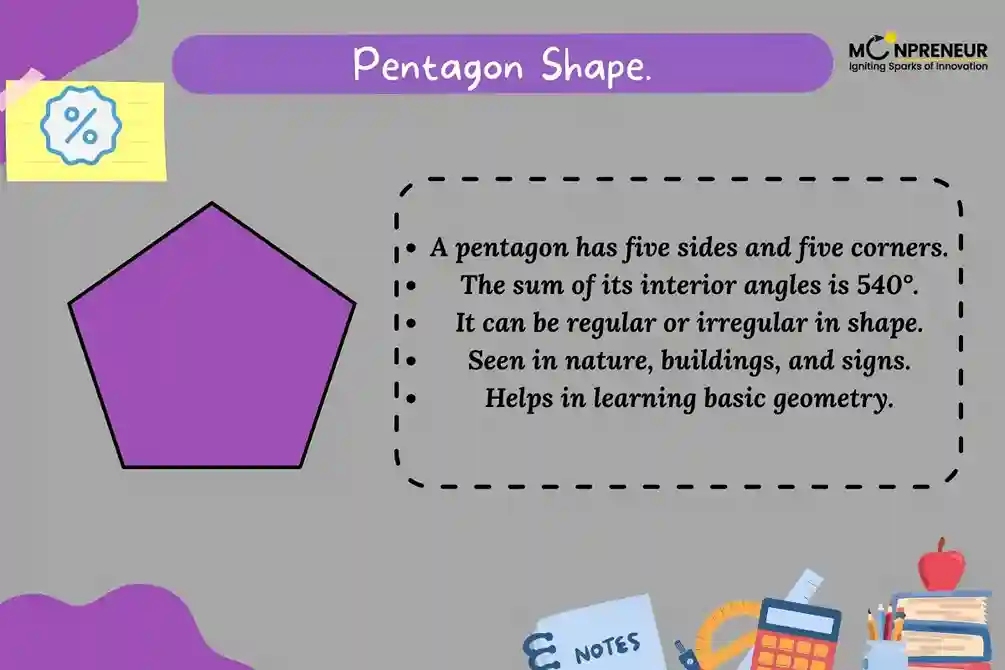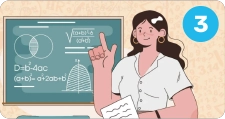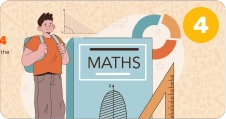Introduction
A pentagon shape is a fascinating and important figure in geometry that appears in buildings, signs, and art. The word pentagon comes from the Greek words “penta” (meaning five) and “gon” (meaning angles). Simply put, a pentagon is a five-sided polygon. Each of its five straight sides connects to form five angles, making it unique and easily recognizable.
Whether you are a student learning geometry or a parent helping your child, understanding the pentagon shape can be both fun and useful.
Definition of a Pentagon Shape

A pentagon shape is a flat, two-dimensional polygon with five sides, five vertices (corners), and five angles. The sum of its interior angles is always 540 degrees.
Formula for the sum of interior angles of a pentagon:
Sum of interior angles = (n − 2) × 180°
Here, n = 5, so:
(5 − 2) × 180° = 540°
Types of Pentagon Shapes
- Regular Pentagon
- All five sides are equal.
- All five interior angles are 108 degrees each.
- Symmetrical in shape.
- All five sides are equal.
- Irregular Pentagon
- Sides and angles are not equal.
- Shape varies but still has five sides.
- Sides and angles are not equal.
- Convex Pentagon
- All interior angles are less than 180°.
- Sides do not intersect each other.
- All interior angles are less than 180°.
- Concave Pentagon
- At least one interior angle is more than 180°.
- One or more sides bend inward.
- At least one interior angle is more than 180°.
Properties of a Pentagon Shape
- Number of sides: 5
- Number of vertices: 5
- Number of angles: 5
- Sum of interior angles: 540°
- Exterior angles: Always add up to 360°
- Number of diagonals:
Formula: \(\frac{n(n – 3)}{2} = \frac{5(5 – 3)}{2} = 5 \text{ diagonals}\)
Perimeter and Area of a Regular Pentagon
Perimeter (P):
P = 5 × side length
Area (A):
\(A = \frac{1}{4} \times \sqrt{5 \left( 5 + 2\sqrt{5} \right)} \times a^{2}\)
Where a = length of a side
Real-Life Examples of Pentagon Shapes
- The Pentagon Building in the USA
- Home plate in baseball
- Certain flowers with five petals
- Geometric patterns in art and design
- Some road signs and shields
Fun Facts About Pentagon Shape
- A regular pentagon can be perfectly inscribed in a circle.
- The pentagon star (pentagram) is formed by connecting the vertices of a regular pentagon.
- Many natural organisms, such as starfish, display pentagonal symmetry.
Why Learn About Pentagon Shapes?
Learning about the pentagon shape improves spatial understanding and geometry skills. It has real-world applications in architecture, design, and pattern creation. For kids, recognizing shapes like pentagons builds a strong foundation for advanced math concepts.
Conclusion
The pentagon shape is more than just a five-sided polygon — it’s a fundamental geometric figure with fascinating properties and countless real-life applications. From architecture to nature, pentagons appear all around us, making them an essential part of both learning and everyday observation. Understanding the definition, types, and properties of pentagons helps build a strong foundation in geometry, especially for students. Whether regular or irregular, concave or convex, the pentagon stands out as a shape worth exploring and appreciating.
Want to spark your child’s interest in math and boost their skills? Moonpreneur’s online math curriculum stands out because it engages kids with hands-on lessons, helps them apply math in real-life situations, and makes learning math exciting!
You can opt for our Advanced Math or Vedic Math+Mental Math courses. Our Math Quiz for grades 3rd, 4th, 5th, and 6th helps in further exciting and engaging in mathematics with hands-on lessons.
Related Blogs:
How to Teach Adjacent Angles to Kids | Simple & Fun Guide
What are Congruent Angles?
Understanding Alternate Interior Angles
What is the Area of Trapezoid?
What is the Area of Parallelogram?
Understanding the Geometry Regents: A Comprehensive Guide
How to Prepare for the Geometry Regents: Study Plans & Practice
The Art of Geometry: How to Draw an Equilateral Triangle Inside a Circle













